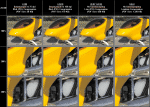|
Step 1 |
Changing Printer Output Settings You can change various settings to optimize the quality and file size of your PDF. These settings only apply to the current printer output (ie the data just received from the printer, but not yet converted to a PDF). You cannot change these settings for a PDF file that has already been saved.
Picture Quality You can reduce the file size by choosing a lower quality setting.
This savings is achieved by down sampling high resolution pictures in your document to a lower resolution and by increasing the compression ratio for pictures. Viewing the PDF document at 100% zoom with Low Quality will maintain the original picture quality, but the details will be lost when zooming in. This setting will have no effect on documents which do not have pictures. Picture quality and resolution cannot be improved from the original picture. The resolution of the pictures are decreased to 150 dpi (Good setting) or 75 dpi (Low setting). The resolution of the original picture is maintained if you select High or Very Good settings. (click picture for full size version) Color Model
Fix Page Rotation
Add Web Links This setting allows you to convert Hyperlinks in the PDF into a clickable link. There are some limitations:
|
Setting Metadata of a PDF File
|
Step 1 |
Enter Metadata information (optional) If you wish, you can type in information about the PDF file which is searchable by databases and other utilities. You can enter information for the following four parameters:
|
Setting Metadata information for an existing
file (optional)
|
PDF Output Settings
|
Step 1 |
Changing PDF Output Settings When saving PDF files, you can change the following settings.
View PDF File after it has been created
View Style
Optimize for Fast Web View
|
Printer Resolution
|
Step 1 |
Changing Printer Resolution The printer, by default, is set to 300 dpi (dots-per-inch) which give a good compromise between output quality and file size. You can manually adjust this setting through the printer properties control panel as follows.
|

